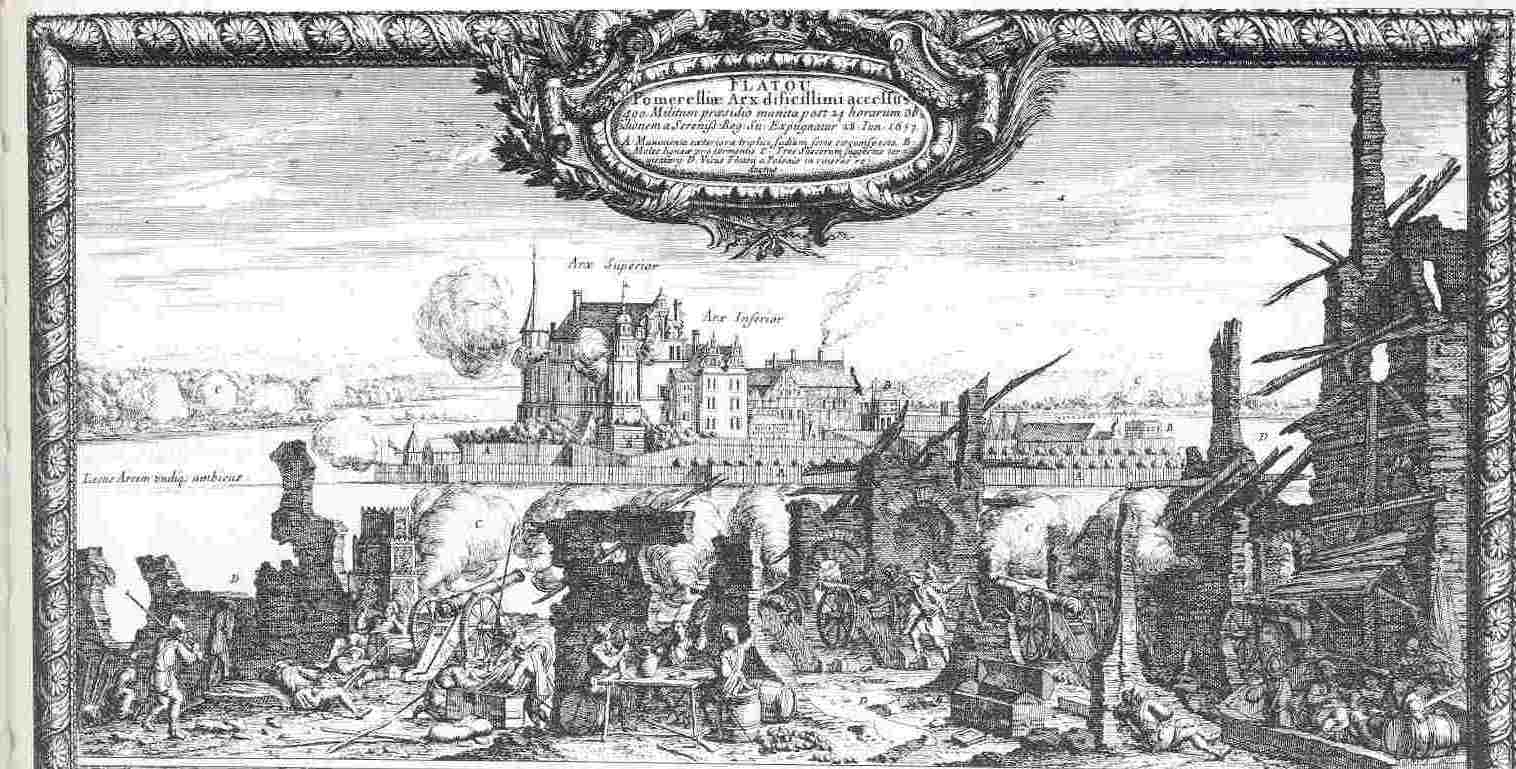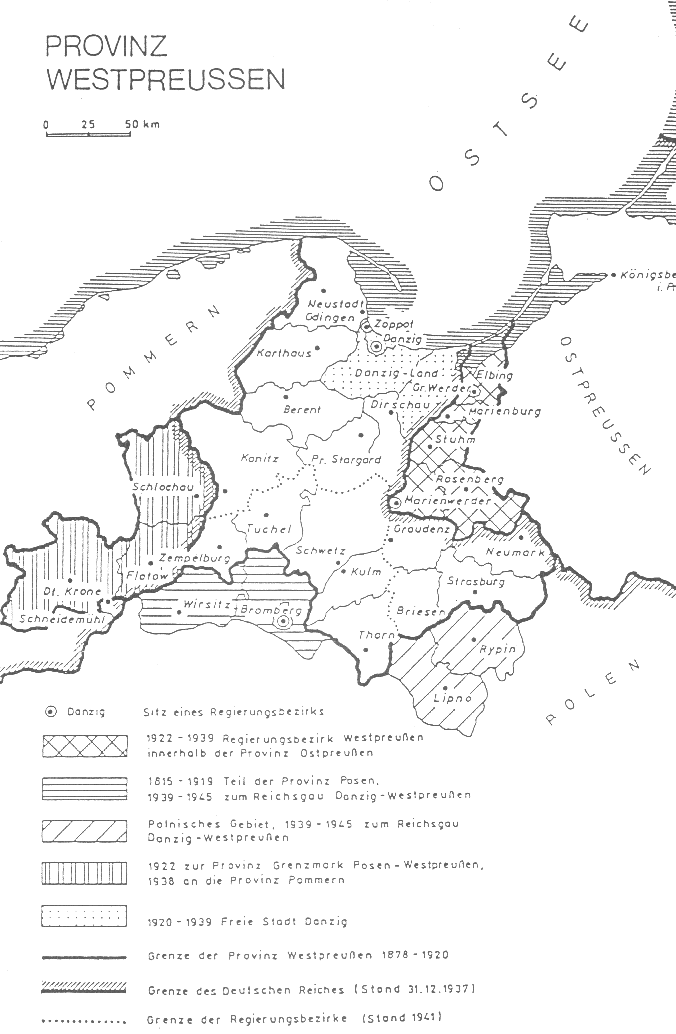The
Remus Family of West Prussia:
Millers,
Village Heads (Schultz), Shepherds, and Farmers
(and a general introduction to West Prussia)

Flatow,
West Prussia on 28 June 1657 after the Attach of the Swedes during the 13 Years
War
(Click here to see how the castle site looks in
2004)
West Prussia is a region on the modern north
coast of Poland. It was located between Pommern and
East Prussia. All three of the latter regions were part of Prussia. I might
note here that this region was given the name West Prussia after the Partition
of Poland in 1772. It was located between Pommern and
East Prussia. Prior to that time it was know as Royal
Prussia, Ducal Prussia, and several other names. For a good history of this
area prior to the Partition, see way Friedrich, The Other Prussia,
Cambridge University Press, 1999. I will use the name West Prussia on these web
pages since this was name of the region at the time of the great migrations to
America, Canada, and Australia. Here is a map of West Prussia:

Remus
Family Migrations from Saxony to West Prussia
The Remus family
has been long established in Saxony. The earliest records I have for this
family name are from 1491 in the town of Kamenz where we find
Burgers by that name. Remus families still live in the area. Also the nearby
town of Grossenhain contained Remus family members going back to at least 1560 (probably
related to the Kamenz
Remus family). These are the families that migrated to West Prussia. Click here
for a Summary of the Evidence of This Migration. Click here for the Top Reasons that They Chose to
Migrate.
The earliest
appearance of the Remus name in Poland begins to show up circa 1586 in the
records of the city of Danzig
(modern Gdansk) on the northern coast of Poland (see the above map). This city
was the major city in a quasi-independent state known as Royal Prussia.
Officially the nobles in Royal Prussia were part of the Polish state's
governing system but in reality Royal Prussia went its own way (Friedrich, The
Other Prussia, Cambridge University Press, 1999). The economic power of
Danzig was that it was a transshipment point of grain going out of Poland and
goods coming into Poland by the Baltic Sea routes. It was part of the Hanseatic
League of Baltic trading cities and a fairly wealthy city for that time. Click
on Martin Remus of
Danzig to find the genealogy of this
pastor at St. Mary's (Marienkirche) in Danzig; he was
born in Saxony (see Grossenhain Saxony) and migrated to Danzig before 1586. Click here to find out why he made the move. Click here for lots of
details on Martin's life and career including lots of pictures and history of
the Danzig area. Click here to find out
more about Martin Remus in Saxony.
The above was an
unusual case. What generally happened in the West Prussia migration reflects
circumstances in Saxony. Some of the members of the Remus family were Burgers
(perhaps as town Millers but certainly as soap makers and commercial cooks) in Kamenz. As such they
had access to financial resources and to the political power of Saxony. They
ended up with the funds and connections to become the Schultz, Burgers, and
Millers of West Prussia. It is likely this Burger family had the resources to
support the education of Martin Remus at University of Leipzig who lived
initially in the nearby town of Grossenhain and was a pastor in Danzig (see above).
Some members of
the Remus family did not have assets but still migrated. So there were Remus
family members who worked on estates in Saxony like Bischhein. When this second group arrived in West Prussia, they
worked on estates, became day laborers, and became shepherds.
The first wave
of migration was in the 1600's when Remus family members moved from Saxony
to the estates in Neumark, an area in Poland then a
part of Brandenburg/Prussia. Some were just workers but others like the Remus
family in Braunsfelde in Neumark were millers. They probably moved
on to West Prussia at the same time as the second wave of migration about to be
discussed.
The second wave
of migration resulted from the Great Northern war. The Great
Northern War devastated the northern
part of Poland. The war had two major phases in northern Poland, the first
around 1650 and the second around 1704. Saxony was a participant in both phases
and Remus family members fought in both phases. It is estimated that one-third
of the people of northern Poland were killed in that war. In the aftermath of
the war (that is around 1720), the Remus family settled in what was to become Kreis Flatow and Kreis Schlochau in West Prussia.
Also helpful was the patronage of Augustus the Strong King of Saxony and Poland
who provided small land grants for the service in his
armies like that to Michael Remus of Pollnitz, Kreis Schlochau. By 1772 the
Remus family was also in Kreis Tuchel,
Kreis Schwetz, Kreis Berent, Kreis
Wirsitz, and Kreis Preuss Stargard in West Prussia.
See the map above. This area of northern Poland previously known as Royal
Prussia was known as West Prussia after 1772. (Note: Kreis
corresponds to county in English.)
As noted earlier,
some of the Remus families in West Prussia were village heads (click on schultz to find
out more about this job and settlements
to find out how villages were organized), tavern owners/inn keepers (click on krugers for more details), and millers. Click here to attend a
church service in Flatow.
Want to be top dog in a West Prussian village, click Top Dog for
details. These people will be described in great detail after a brief
discussion of the rest of the Remus family.
Shepherds,
Day Laborers, and Estate Workers
Many Remus family
members arrived in West Prussia and are listed as shepherds (click on schafer for details), estate workers, day laborers, and
farmers in the 1772 Land Census. Roughly half the Remus family members listed
fall in this category.
When these Remus
family members arrived in West Prussia they had neither financial assets nor
political connections. So they took the only jobs available to them. These jobs
were being a shepherd, day laborer, estate worker, or small farmer usually
attached to an estate. This became apparent when I looked into the nature of
the villages they lived in around 1772 - many of these villages were connected
to a large noble estate. The maps would show an estate house with a few small
houses nearby.
In the end, many
of these families did acquire their own farm, although often in sandy soil.
There were two
subsequent migrations out of Saxony to Prussian northern Poland. Some
migrated after the partition of Poland in 1772 to take advantage of the
incentives for German settlement offered by the Prussian government. Others
migrated following the takeover of Saxony by the Prussians in the early 1800's.
The Remus family
was not in Pommern (Pomerania in English) until the
early 1800's. Again the Pommern migration
was about economic opportunities. What happened was that Pommern
was a region of feudal estates owned by nobility up until the early 1800's. In
the early 1800's, the Prussian government broke the power of the nobility and
the German serfs were released from their bondage to the estates. They left Pommern for places like America and Russia leaving farming
opportunities (in Kreis Stolp
taken up by Remus family members from West Prussia) and shepherding
opportunities (in Kreises Pyritz,
Stagard and Griefenhagen).
And of course the greatest
migration of Remus family members was to North America beginning in about
1860.
Click here to find out more about millers and the
Remus family millers in particular.
Click here to find out more about the Remus family farmers and shepherds.
Click here to go directly to other West Prussia villages.
Would you like to see these places?
Please
send any queries to Bill Remus at
April
2, 2018